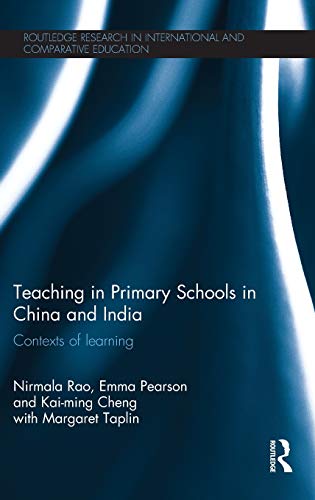

Most ebook files are in PDF format, so you can easily read them using various software such as Foxit Reader or directly on the Google Chrome browser.
Some ebook files are released by publishers in other formats such as .awz, .mobi, .epub, .fb2, etc. You may need to install specific software to read these formats on mobile/PC, such as Calibre.
Please read the tutorial at this link. https://ebooknice.com/page/post?id=faq
We offer FREE conversion to the popular formats you request; however, this may take some time. Therefore, right after payment, please email us, and we will try to provide the service as quickly as possible.
For some exceptional file formats or broken links (if any), please refrain from opening any disputes. Instead, email us first, and we will try to assist within a maximum of 6 hours.
EbookNice Team

Status:
Available4.7
22 reviews
ISBN 10: 0415815525
ISBN 13: 9780415815529
Author: Nirmala Rao, Emma Pearson, Kai ming Cheng, Margaret Taplin
This book compares primary education in urban and rural China and India. It focuses on how the sociocultural context including educational policy, educators and parents’ beliefs, and the conditions under which teaching and learning occur shape classroom pedagogy and determine children’s attainment. This in-depth, authentic, comparative analysis of the two largest educational systems in the world is a must-read for scholars interested in the teaching and learning in these two rapidly developing Asian cultures. A common set of questions has been addressed in diverse contexts. The empirical work on which this book is based is most impressive – videotaping of mathematics and language lessons, interviews with parents and educators questionnaires with parents, teachers and children and tests of children’s mathematics attainment – and this done in 3 locations in China, 3 in India and 12 schools in total.
1 Introduction
The Dragon and the Elephant
Economic Development
Human-Development Indicators
Historical Background of Education in China and India
Primary Education
Methodological Approaches to Studying Teaching Across Cultures
Background and Objectives of the Study
Organization of the Book
2 The National Context Education Policy and Implementation
Overview of School Education in China
Structure
Educational Policies and Management
Overview of School Education in India
Structure
Educational Policies and Management
Educational Indicators in China and India
Factors Influencing Primary-Education Policy and its Implementation
National Goals
Characteristics of the State
Emphasis given to Different Stages of Education
Children's Rights
The Policy-Implementation Link
3 The Local Contexts
Zhejiang and Andhra Pradesh
Selection of Schools and Classes
Zhejiang
Economic Development
Educational Development
Location and Geographical Features of the Research Sites in Zhejiang
Andhra Pradesh
Economic Development
Educational Development
Location and Geographical Features of the Research Sites in Andhra Pradesh
Schools in Zhejiang and Andhra Pradesh
4 The Classroom Context Teaching and Learning Mathematics
Teaching of Mathematics in Primary-Schools in China
Whole-Class Instruction
Methods to Promote Mathematical Understanding
Differences between Urban and Rural Schools
Mathematics Curriculum Reform
Teaching of Mathematics in Primary-Schools in India
Whole-Class Instruction
Methods to Promote Mathematical Understanding
Mathematics Curriculum Reform
Method
Participants
Procedure
Data Management
Results and Discussion (China)
General Classroom Observations for Mathematics Classes
Lesson Transcripts
Educational Reform and Classroom Practice
Results and Discussion (India)
General Classroom Observations for Mathematics Classes
Mathematics Achievement
General Discussion
Commonalities and Distinctions between China and India
5 The Classroom Context Teaching and Learning Language
Method
Transcript Analyses
Results (China)
Structure of the Lessons
Methods of Teaching
Methods of Promoting Understanding
Methods of Encouraging Student Participation
Child Volunteering to Add some Further Information
Results (India)
Structure of the Lessons
Methods of Teaching
Methods of Promoting Understanding
Methods of Encouraging Student Participation
Language of Instruction and Attainment
Discussion
Learning about Language, Culture, Morals and Values
Questioning
Student Participation
6 Policy-Makers', School Principals' and Teachers' Views on Teaching and Learning
Zhejiang
Key Recent Developments
Challenges
Teacher Training/Professional Development
Summary – Zhejiang
Andhra Pradesh
Recent Developments
Challenges
Teacher Training/Professional Development
Summary – Andhra Pradesh
Conclusions
7 Parents' and Students' Views on Schooling and Achievement
Attribution Theory – Some Cross-Cultural Findings
Attributions for School Success and Failure among Parents and Students in Andhra Pradesh and Zhejiang
Parent and Child Attributions for School Success and Failure
Parents
Children
Summary/Implications
Parent Questionnaire Part A – Beliefs Related to Socialization and Education
Parent Questionnaire Part B – Beliefs Related to School Motivation
Teaching and Learning in India and China – the Influence of World Views
Cultural Values that Underpin Teaching and Learning in India and China
8 Teaching and Learning in Chinese and Indian Primary Schools
Why China and India?
Why Look at the Classrooms?
Factors Affecting Quality Education
Cultural Beliefs
Historical Legacy
The Role of the State
teaching primary school in china
china primary school textbook
primary school china
chinese primary school curriculum
elementary schools in china
china school textbooks
Tags: Nirmala Rao, Emma Pearson, Kai ming Cheng, Margaret Taplin, Primary, China